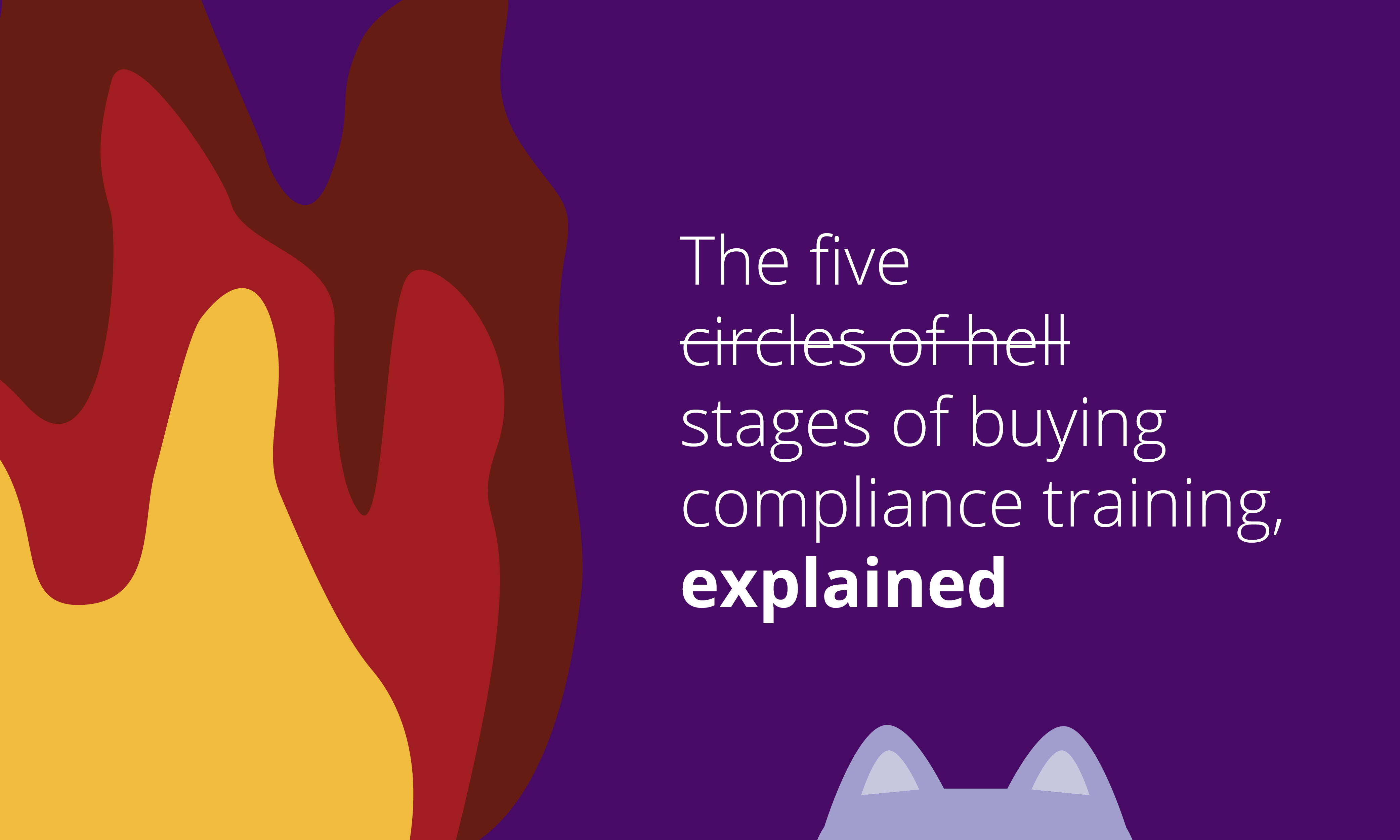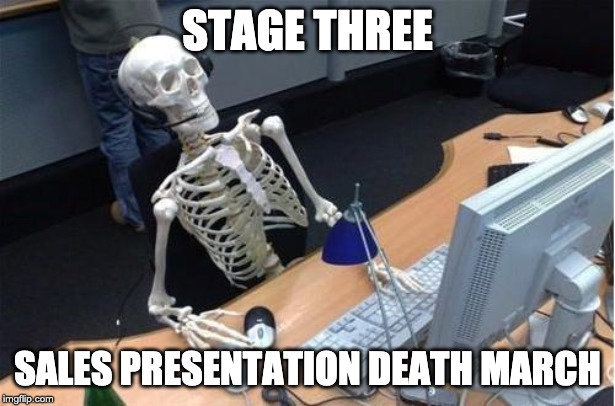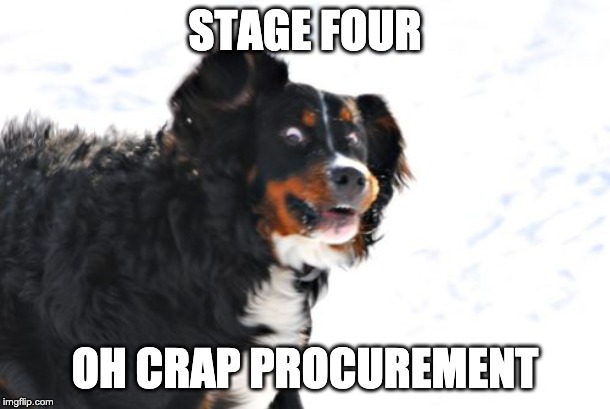
The five (circles of hell) stages of buying compliance training, explained.
There is probably no more soul-crushing task than being assigned to buy compliance training for a large organization. (“Assigned” is operative; no one has ever asked to be responsible for this.)
If you ever want to get out of a conversation at a cocktail party, for example, just tell the other guests that your job is procuring compliance training for a large corporation and the conversation is over. Especially if no one asked about your job and you just blurted it out while someone was telling a story about their thrilling escape from kidnappers when they were doing humanitarian work in the Congo with Doctors Without Borders.
This is, naturally, the recommended way to exit any conversation.
Now: the reason buying compliance training is so awful is because it is one of those parts of life that no one in particular really cares about too much. Even if you care a lot about compliance training itself, you probably don't care enough about the process of buying it to fix how horrible it is—you just suffer through it.
This neglect has metastasized through the addition of dumb requirement after dumb requirement, year after year, into a diabolical Mobius Strip of self-reinforcing and totally unnecessary process.
It’s kind of like how buying razors at the grocery store went from “this is fine” to “why is the packaging so extensive” to “why do I have to ask someone to come with a key and let them out of razor prison so I can buy them are these razors made of gold or cocaine or something.” That happened through entropy, and it was totally nuts but we all kind of went along with it—at least until Dollar Shave Club came along and blew all that apart.
(And…foreshadowing.)
(But if you can’t wait, click here to jump to what we’re doing about it.)
I know that not everyone’s had to go through this, and if you haven’t done it then you might have a delightfully naïve view that I’m “using hyperbole” and it’s “probably not that bad” and it “will be fun to listen to all of these vendors” and to you I say this:
Which I say with love because I want to spare you from this. Lots of people have thought this wouldn’t be that bad; no one makes that mistake twice.
But I get it, you need details. So here: if you’ve never had to do it, this is what it’s like.
Hello darkness, my old friend.
Buying compliance training is like reading an early draft of Kafka’s “The Trial” that he junked for being “too on the nose.”
Just to set the mood, watch this Vine. We’ve shown you this one before.
OK, see that? That is the right mood.
I mean, almost. Technically, to set the right mood, don’t imagine that you are the guy in the Elmo suit.
Instead, imagine that you are the guy at the costume rental place who is in charge of cleaning that water-logged Elmo suit once it’s returned later that evening, which you do in a small basement office illuminated by a bare light bulb that gently sways back and forth in time to the waves of crushing regret that wash over you as you play back all of the choices that led to that moment.
Got it? Good.
Because that is a feeling you will know intimately if you are given this assignment.
Most likely, it will be given to you because you, like a fool, took vacation right when your boss realized that the training contracts were up and everyone else was like NOT IT.
So imagine that you have just returned from vacation, ready to ease back into work, only to find out that you have been tasked with buying compliance training because everyone else said “not it” and that is how you decide things at your company.
You will then descend into the first circle of hell start the first stage of buying compliance training.
Stage One: Denial
For about two days, you will stare blankly into space, because you will be like “what” and “how” and “huh.”
You easily justify this because it was already Wednesday which is basically the weekend so there wasn’t really any point in getting started until Monday anyway.

Stage Two: Stupidly optimistic research
That Monday, you drink a carafe of coffee and decide to make the best of a bad situation. You assume, stupidly, that this is like everything else in the entire world and you can probably do most of the work online.
So you run a few searches and start clicking on the top results.
After a few hours, you start to wonder if someone put LSD in your coffee. You not only feel dumber than before, but you also have a sneaking suspicion that you are losing your grip on reality—which is bad, at least if the invisible crocodile whispering taunts to you from the corner of your office is to be believed.
You then realize that all of the stuff you have been reading was crafted for search engine optimization—that’s why those sites were at the top—meaning that they are chock full of buzzwords (BEST ONLINE COMPLIANCE TRAINING SCORM-COMPLIANT KENDALL JENNER ICE BUCKET CHALLENGE!!) but say nothing meaningful.
Because you know this type of tactic indicates a commodified product, this is the first time you think “huh, maybe it doesn’t matter what I pick,” but you banish that thought to a dark place for the time being.
You will eventually come across sites that are different (BRAG BRAG) but by that point you will have given up on actually reading anything, because all of the companies that appeared at the top of your search are the ones who put all the effort into gaming the search engine with corporatespeak gibberish, and by this point you just are too tired to care.

Stage Three: Sales presentation death march
So, you start asking vendors to call you, assuming this will be a better way to gather information.
You are wrong, but hey, live and learn.
You slog through about forty hours of pre-screening, discovery, and requirement calls, all of which are with a guy named Chad. You start formulating elaborate multiverse theories to explain this and decide that maybe Chad is like the Borg from Star Trek. You accept that resistance is futile and give in to The Chad, which allows you to finally get to some kind of webex or in-person presentation.
All of these presentations are pretty much the same. Some attractive person in a suit comes to your office and loads up a PowerPoint deck. There is some awkward small talk; there is a slide with all of their clients on it; there is a demo of a training course that is like, fine, you guess.
There is some talk about “adult learning best practices,” which has nothing to do with Adult Learning Theory as put forth by Malcolm Knowles and instead is simply “this is learning for adults, therefore it is adult learning.” You would dig into this but at this point your phone has gone off and then you decide to check Facebook real quick and then whoops it’s over.
You thank the salespeople and ask for information to be sent to you. You get some specific information to request from someone in your Learning & Development department; much like you, this person also drew the last straw and doesn’t want to do this either. So the questions they give you aren’t tailored for the compliance use case and reflect a reliance on Dale’s Cone of Learning, which they will summarize to you as “interactive = better."
A small amount of research would show that this is galactically wrong, but your L&D person just wants to get back to their normal work so doing more research than the first few Google results is not going to happen.
The salespeople, keen to do their part in this danse macabre, dutifully send you all of this information in the specific format you requested. That format is “a poorly-formatted PowerPoint converted to PDF so it’s really hard to cut-and-paste the information.” You regret requesting this format.
You take all of this information and create an elaborate, color-coded spreadsheet in Excel. There are at least three columns that address vendor specifications that you do not understand and are reasonably certain are just made up, but some of the vendors touted them so they must be important.
At this point, you survey your work and then remember that every employee at your company will hate all of this stuff no matter what you choose.
So you decide to recommend one at random and move on to…

Stage Four: OH CRAP PROCUREMENT
Satisfied with your selection, you get ready to present to your stakeholders and
OH CRAP DOES THIS NEED TO GO THROUGH PROCUREMENT. WHAT DOES THAT EVEN MEAN. DOES ANYONE KNOW ANYONE IN PROCUREMENT.
OH NO DOES THIS NEED TO GO THROUGH LEGAL TOO—IT DOES?
NO, I’M SORRY, I DIDN’T KNOW. PLEASE STOP LECTURING ME.
THIS IS GOING TO TAKE ANOTHER THREE MONTHS? BECAUSE THAT'S JUST HOW THIS WORKS FOR NO REASON?
GREAT.
That is, you have to work with procurement. You start to work with procurement in good faith, but your spirit officially breaks when you have to submit the same information for the third time in a slightly different format.
You later realize you should have expected this, because “procurement” is based on a derogated Latin phrase that means “reformatting the same Excel spreadsheet for the third time.”
You start to get a thousand-yard stare and enter…

Stage Five: Not caring
Your spirit totally broken, you assess your options while gaining a deep, spiritual appreciation for this Vine:
You determine that there are three realistic paths forward:
1. Keep banging your head against the wall to try to punch through to the other side.
Push ahead, slogging through the brutality of procurement, all so you can then slog through the brutality of legal review, and then slog through the brutality of vendor onboarding, and then slog through the brutality of implementation, all so some employee can send you a long complaint about how he doesn’t like the narrator for one of the courses and then you have to deal with that and be like “is this seriously my life.”
2. Give the long kiss goodnight.
Update your resume and try to find a new job so finishing this becomes Someone Else’s Problem. Keep scheduling “vendor review” meetings to see if the project will just go away if it is stretched out long enough, killing this project the way most things die at big organizations: lack of momentum.
3. Ghost ride the project.
Ghost the vendor you selected and do it yourself. Not because you think this is a good way to handle business relationships (it isn’t) or that it’s a good use of your time (it’s not) or that you can do it cheaper internally (you can’t), but because your spirit is broken. Convince yourself that paying a full-time employee to spend all day scrolling through ClipArt is a good use of company resources.
You think about it and pick—you know what, it doesn’t matter, every part of this is just terrible.

What if it wasn’t?
So, you get the idea. This is horrible. But what if it wasn’t?
What if you could learn what you needed online?
What if there was a buyer guide that explained everything?
What if you could buy online, without ever having to print out a PDF for your boss to sign promptly lose?
What if you could avoid procurement hell by buying in at a price point well below the RFP—that is, the Relentless Frustration and Pain (sorry)—threshold?
What if you could avoid chasing your contract lawyer for six weeks because you just were simply buying things rather than going through some complicated commercial nonsense—just like how easy it is to buy a subscription to the Wall Street Journal?
What if you could go from “this works” to “I have it” in ten minutes instead of ten months?
You can with Compliance Design Club.
We’ve been doing compliance design for years—way before the Department of Justice started talking about having a “well-designed program.”
And with Compliance Design Club, we took all the design horsepower we were using to solve compliance problems and applied it to the problem of how incredibly soul-crushing it is to simply buy something at a large organization.
With Compliance Design Club, you can:
- Learn everything you need to know online.
- Join the Club in literally minutes with our fully online form.
- Pay your membership dues online with a credit card and expense it…
- …which you can do because the entry point is so low. (You can scale up later after you know that you love it.)
You really can go from “I would like this” to “I have it” in minutes, and we’ve already had multiple companies do just that. And of course, we’ll talk to you if you need information—but you don’t have to, because our buyer guide is that clear.
And the best part? It’s not the same old clunky e-learning, cringey stock-photo garbage that uses stilted corporate boilerplate approved by the Ministry of Newspeak.
Instead, it’s all the design-first materials you need to tackle that key “well-designed” question from the Department of Justice’s guidance—the kind that gets showcased by the DOJ's former compliance expert as an example of "Next-Generation Compliance."
....
It’ll help you modernize your program, bit by bit, with plans that grow with you.
Want to know more? Just click here. You can even try it for free!




